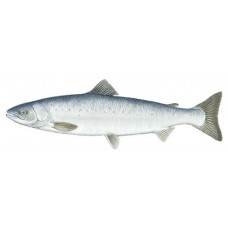Latin name
Salmo salar
Other names
Sea-run fish, grilse, grilt, fiddler, Kennebec salmon; Danish and Norwegian: laks; Dutch: zalm; Finnish: lohi; French: saumon Atlantique, saumon d’eau douce; German: lachs, las, salm; Italian: salmo, salmone; Japanese: sake masu-rui; Portuguese: salmao; Russian: losos; Spanish: salmón del Atlantico; Swedish: lax.
Identification
Compared to its body size, the adult Atlantic salmon has a small head. Its body is long and slender, and the tail fin in adults is almost square. Most males have slightly forked tails. At sea, Atlantic salmon has a dark blue head and back, its flanks are silvery, and its belly is white. The fins are dark, and there are numerous black markings on the head and along the body above the lateral line in the shape of an X or Y. When a fish enters fresh water to spawn, it gradually loses its metallic luster and becomes dull brown or yellowish. The gill stamens are elongated, spiky (no thickening). The maxillary bone reaches the vertical of the posterior margin of the eye or slightly goes beyond it. The caudal fin is strongly carved in juveniles and weakly in adults.
Distribution
The northern part of the Atlantic and western part of the Arctic Oceans, from where it enters the rivers of the European and American (from Hudson Bay to the Connecticut River) coasts. On the shores of Europe, it occurs from the Cara River to the Duero River (Iberian Peninsula). There are in the White and Baltic Seas. On the coasts of England, Spain, Iceland, in lakes Ladoga, Onega, large lakes of Sweden, the Great Lakes of North America. Native Atlantic salmon have been extirpated from much of their southern range, victims of industrial growth, dams, pollution, and other factors. Self-sustaining populations of anadromous Atlantic salmon exist in Canada, especially in Quebec, but also in Newfoundland, New Brunswick and Nova Scotia.
Habitat
A migratory fish. It lives in the sea or large lakes and enters rivers to spawn. After spawning, most die. Anadromous Atlantic salmon spend most of their lives in the ocean, entering coastal rivers to spawn. They are found in fresh water only during spawning.
Size
It is 150 cm long, weighs 39 kg (Pechora River) and even 46.5 kg (Neman River estuary). In the river the salmon grows very slowly, in the sea - very quickly. Puberty is usually 5 years. Atlantic salmon can live for 8 years and is the second largest of all salmon species. Unofficial historical reports speak of specimens weighing up to 100 pounds. The world record set with all tackle is a specimen weighing 79 pounds 2 ounces was set in Norway in 1928. Today, most specimens weigh no more than 20 pounds, and fish weighing more than 30 pounds are rare.
Life history and Behavior
Spawning usually occurs on the gravel bottom at the head of the riffles or in the tail of the pool in the evening or at night. Unlike Pacific salmon, adults do not die after spawning. Emaciated and skinny, they often return to the sea just before winter or remain in the stream until spring. Some survive to spawn a second time.
Food and feeding habits
Salmon grow rapidly in the ocean, feeding on crustaceans and other fish such as smelt, herring, capelin, mackerel, and cod. They do not feed upstream during their spawning migration. Juveniles feed in rivers on aquatic larvae and adult insects, and in the sea mainly on herring, sand lance and crustaceans. In rivers, adults do not feed at all. The feeding takes place in the North Atlantic, the Norwegian Sea, and off West Greenland. Here, fish from different herds mixing.
Reproduction
Spawning takes place in autumn and winter at a water temperature of 10 to 0 °C at depths of up to 1 m in areas with a fast stream. The female digs holes on the river bottom in several places, in which she lays eggs; after fertilization, she buries the nests in sand or gravel. Fertility is from 6 to 26 thousand eggs. The eggs are bottom-dwelling, non-glutinous. The eggs are 5-6 mm in diameter. Their development lasts 13-19 weeks, until April-May. Larvae that hatch by this time stay in the nests for 30-50 days. When the yolk sac is completely dissolved, they ascend through the spaces between the pebbles closer to the surface.
Interesting facts
Salmon can travel thousands of miles to fulfill their purpose. They are trained from birth to swim long distances, learn to jump and navigate. Sometimes the fish must swim more than a thousand kilometers against the current. Their elongated, spindle-shaped bodies allow them to swim long distances without tiring.
| Classification | |
| Phylum | Chordata |
| Class | Actinopterygii |
| Squad | Salmoniformes |
| Family | Salmonidae |
| Genus | Salmo |
| Species | Salmoniformes |
| Features | |
| Conservation status | Least Concern |
| Habitat | Pelagic |
| Life span, years | 13 |
| Maximum body weight, kg | 43 |
| Maximum length, cm | 1.5 |
| Sailing speed, m/s | 1.1 |
| Threat to people | Edible |
| Way of eating | Predator |




